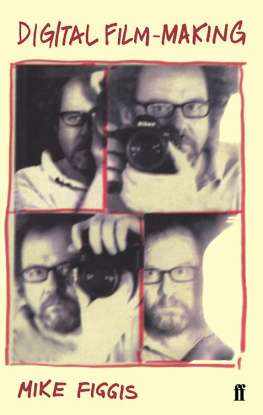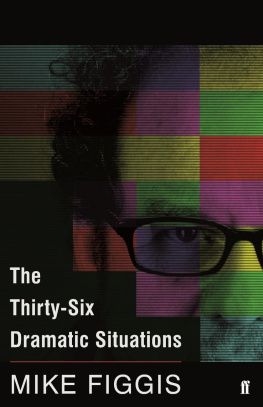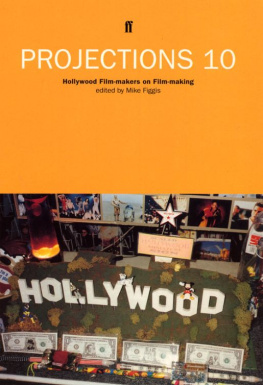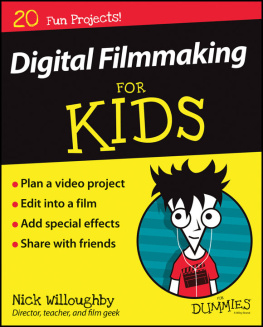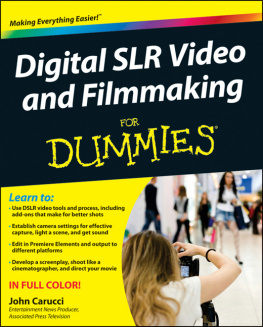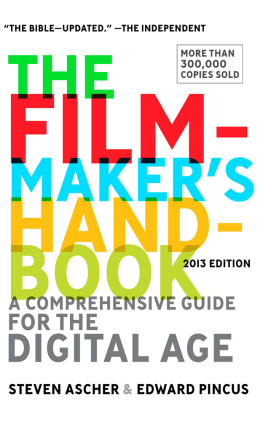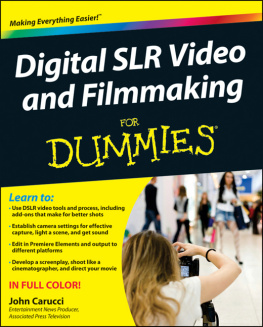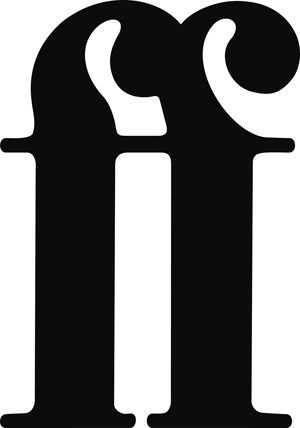I clearly remember the sense of frustration I felt when I began making films. Ive always been fascinated by process, by how things work, and Ive always asked questions. So I was hungry for information, but no-one would give it to me. Id experienced a similar stone-wall when I studied music. It seemed to me that the people who knew stuff werent crazy about passing on that knowledge. The attitude seemed to be, Thats for us to know and for you to guess. So I resorted to bookshops, the sections on amateur filmmaking How To Make A Super-8 Film and to magazines like Amateur Photographer.
Now that I think of it, the word amateur isnt used very much any more. Nowadays everyone is a filmmaker. There is an interesting reason for this. Back in the day, there were two very big factors that separated the amateur from the pro: money and technology. An amateur filmmaker shot on Super-8, a pro shot on 16mm or 35mm. The difference in equipment and cost was huge. The price of a pro camera was prohibitive, and the cost of processing and post-production so high that only the very rich or the professionals could afford it. But that world has now vanished, and along with it the label amateur.
I suppose I moved from amateur to pro status when I made my first film on 16mm. Then I began using 35mm. Then I began working in Hollywood. And I began to really understand how films were made by professionals. I have to say I wasnt very impressed.
There is a story about Orson Welles which may be true or may be urban myth, but in any case it contains a real truth. It goes like this. At the beginning of the Citizen Kane shoot Welles, whose background was hands-on theatre, moved a light on the set. Greg Toland, the cinematographer, quietly told him that he shouldnt do that the union regulation meant that a specific person moved the lights and no-one else. Welles then had lunch with Greg, who explained all these rules, and a few things more. (I imagine the gregarious Welles lapping up the information, asking lots of questions ) In later years Welles would always say that over the course of that lunch he learned everything he needed to know about filmmaking.
I buy that story. Because the truth is that making a film is very simple. Whats complicated is the co-ordination of many simple elements, all of which need to be addressed at the same time. But the basics of filmmaking are not the same as the basics of brain surgery or rocket science. What I have tried to do in this book is lay out the basics and, in some instances, try to second-guess what might go wrong during the process, and then suggest ways of dealing with these problems.
Above all I want this to be a REALLY USEFUL BOOK. A long time ago I made a resolution with myself that I would never withhold any information that I possessed -I would always pass it on. I teach a lot these days, and I still try to do just that. There is enough information in this book to enable the reader to go out and make a film. The real test for anyone who wants to be a director is a different thing altogether: do you have the patience?
Training the Eye
I got my first stills camera when I was eleven or twelve years old and Ive still got it. It was a point-and-shoot with a built-in flash. I think you got twelve shots per roll of film. I still print off that film today, and the quality is fantastic, because the negative is so big. There was one little switch that put a filter in front of the lens if the daylight was very bright but pretty much all of my shots came out okay. If you think about the amount of time that directors of photography on movies spend with light meters With your first camera, you just pointed it at something and took a photograph.
I then got hold of a very old 35mm camera, a Leica with a fixed lens itself 35mm, fairly wide and I shot some stuff on that. But it wasnt until I got a Nikon camera, and a long zoom lens, that I started taking portraits of people. If you take someones portrait on a long lens, the subject is very sharp while everything in the background and foreground is soft. You start to get abstract shapes forming behind and in front of the subject. And suddenly you realise this is a whole different way of looking at things an artificial way, because the eye doesnt function like that. And you realise these are the images you see in films in war films, say, or any films that want to generate a kind of tension. You realise this is a particular look. And you ask yourself: how do I get this look?
If you then start shooting film on a professional 16mm film camera such as the Aaton, and you get yourself a set of long lenses well, the look you get when you gaze through the Aaton viewfinder is the same as what you got from the Nikon. Suddenly, as you shoot, youre connecting with the prospect of an image, with a look. You sense that what you see is what youre going to get. And just by moving the focus ring, you start to get the power to control the image within the camera. So you begin to build up a kind of language of cinematography and when you start writing descriptions of long-lens shots into your scripts, it shows you have a very clear idea of what you want the film to look like as you are writing it.
I came to these realisations as a result of having shot on a good 35mm stills camera, and then shooting 16mm film on the Aaton. And I would say that as part of your education as a film-maker, the more time you spend with cameras the better it is for you. Whether its a still camera, movie camera, digital camera, its best to become so familiar with the camera that it becomes second nature to you. Every camera has a certain look and gives you a certain feel, and you begin to assimilate certain things unconsciously. Not only are you training your eye by how you use the camera, but youre developing an instinct for what it is you want to achieve. If youve achieved a certain effect through a stills camera, its because youve made yourself familiar with that cameras mechanism. And if you know thats what you want, you can then take a digital camera and you can customise it in the same way like making an extra limb for the camera.
Innovation by Accident
It was Sony, the great innovator, who came up with DAT digital audio tape, a tiny but highly sophisticated tape. The first record-and-playback DAT machines were very well made, very robust, professional machines, not cheap but not fearfully expensive. And almost immediately the industry accepted it: DAT became the format for mastering sound. Certain engineers whom I talked to at the time were horrified. The qualitys great, but wheres your security? This is a tiny piece of tape in a plastic box whereas before, you were using really big four-inch-wide master tapes. DAT wasnt invented as something to take over as the mastering format for recorded sound, but thats the way innovation works.
I feel the same thing has happened with video cameras, just because the domestic cameras now available are so good. For example, a reasonably priced DV camera that you buy in a store today is a better camera than an incredibly expensive hi-tech professional camera from ten years ago. There is no comparison in price. Technology has just moved on. Ten years ago the professional camera was entirely out of reach to anyone other than millionaires. And now we have these things that are almost disposable.
Its phenomenal because up until this new digital era, the technology of film really had not shifted since the 1930s. It just became more sophisticated. Moviemaking technology was a lot like sewing-machine technology, and it worked fine and continues to work fine. There had been no real breakthroughs except, say, Dolby sound, or the invention of the Steadicam. Dolby was invented to deal with the inherent problem of hiss white noise on analogue tape. With digital technology we dont have analogue hiss any more, yet weve become addicted to the sound of Dolby, which is a certain kind of enhanced artificial sound. We accept that now as cinema sound, as reality. Its not. But even though we dont really need Dolby technology any more, were stuck with it. Its part of the deal if you make a film now.

